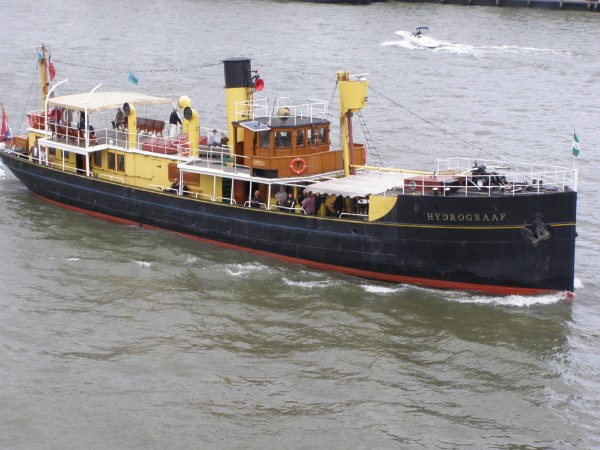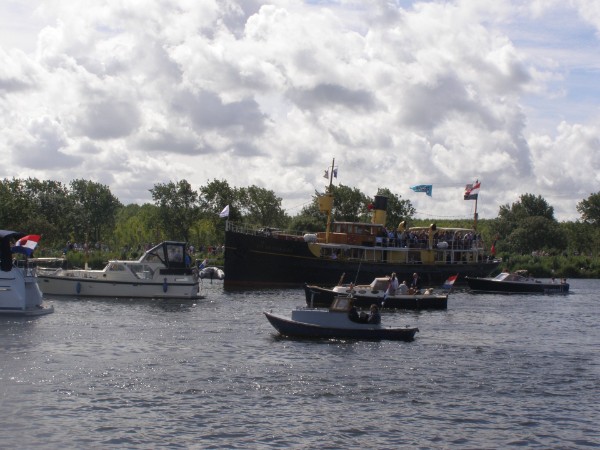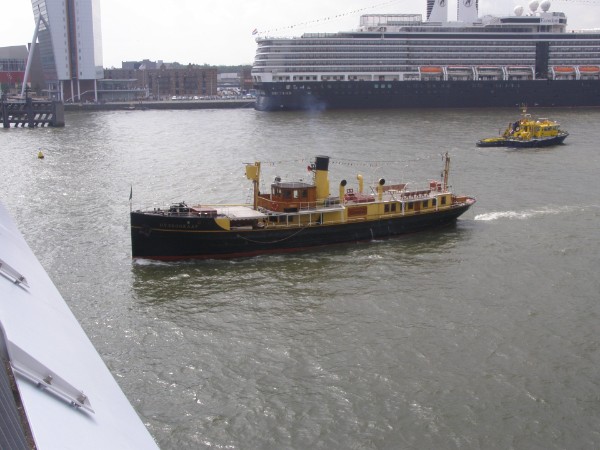Hydrograaf
The Hydrograaf is one of the largest classic steamships in The Netherlands. Building her started at the 11th of october 1909 and she was launched at the 26th of january 2010. The ship was built at the Fijenoord shipyard at Rotterdam, try not to think about the Dutch footballclub with the same name, for the Royal Dutch Navy. Her role was that of a hydrographic researchvessel in the coastal waters of The Netherlands, as well as the Zuiderzee and Waddenzee. That is why she just has a draft of 1,80 meters. She is 40,45 meters long and 6,70 meters wide and she has a displacement of 297 tons. The ship can sail at a speed of around 10,5 knots.
The Hydrograaf has the typical look of a classic steamship, with a crowsnest, exhausts at the deck and a nicely proportioned funnel midships. Also easily recognoizable is the steamflute, fitted to the front of the funnel.

On the 4th of may 1910, the Navy took the ship into service. She only sailed between april and october, because it was not possible to do hydrographic research in wintertimes, due to the weather. In the wintermonths, the ship was mostly in lay-up at Den Helder or Hellevoetsluis. Instead of the normal navy-grey, the ship was painted in yellow and black, the same colouring as is used today.
Next to her naval services,the ship was also used as a Royal yaught when members of the Royal family were visiting the islands of the province of Zeeland. Nowadays, the islands are all connected by an ingenious system of dams and bridges, that were built after the flashflood of 1953. But before 1953, most of the islands were only reachable by boat. QueenWilhelmina, Prince Hendrik and Princess Juliana all used the ship and the ship as nicknamed 'The Queen's Boat'. In the aft part of the ship, a special room was created for the Royal guests. In 1924, during Royal visits to the province of Zeeland, the Hydrograaf was also used as a ferry between the islands.

In may 1940, the ship was relocated to England during the war. She came back to Holland in 1944 when Zeeuws-Vlaanderen, a part of The Netherlands only land-connected to Belgium, was liberated. The ship was used to map the waterways to the port of Antwerp, so this port could be used by the allied forces. After the war, the ship again was back in her old role for the Royal Dutch Navy, untill 1962, when she was replaced by a modern ship under the name of Zeefakkel. The Hydrograaf was the last coal-burner used by the Navy.
After 1962, the ship was used as a trainingship in Rotterdam, Den Helder and Amsterdam, untill 1982 when she was laid up in the Zouthaven of Amsterdam. One year later the ship was bought by Harry Smit, who succesfully restored old ships around the inland sea Zuiderzee. The restored Hydrograaf made her come-back during the festivities of Sail Amsterdam 1985 and since then the ship is used as a partyship with accomodations for around 150 people. Hydrograaf is no longer a steamship, she started misleading people by using smokepots, normally used by the training of firemen, to create the sense of steam from her exhaust. The ship is running on dieselengines now. In recent years, smokepots are part of the law for fire-arms, so nowadays a very strong smokemachine is used to steam-up the vessel.
The Dutch celebration of Sinterklaas at the 5th of december, where a man with a large white beard comes from Spain and hands out presents to children, brings the ship in the news every year, because Sinterklaas (St. Nicholas) is chartering this ship for his journey from the port of Madrid to The Netherlands. Hard to believe? Try and tell the Dutch children, they are just happy with their presents... Funny fact is that maybe when you live in the United States and you try to pronounce Sinterklaas it sounds a little like...Santa Claus. Exactly! This is one and the same person, your Santa Claus originates from a Dutch tradition brought to the United States in the time the Dutch were still important there... And he doesn't come from the North Pole, he is brought from Spain by Hydrograaf or, as the ship is called at these occations, Pakjesboot 12 translated Presents-ship 12 in English.
Nice to know for people who are trying to find a link to passengerships here, Hydrograaf was used between the 30th of august and the 8th of september 2006 as a floating theater in the province of Zeeland. There, she hosted the play 'The disaster of the Titanic' where the ship sailed from several ports in Zeeland with passengers and the story of the Titanic was told, without of course real sinking. The story was used as a metaphore for the demise of the western civilization. Also, Hydrograaf was present in Rotterdam in 2008, to welcome Holland America Line's new ship Eurodam just before she was named.


